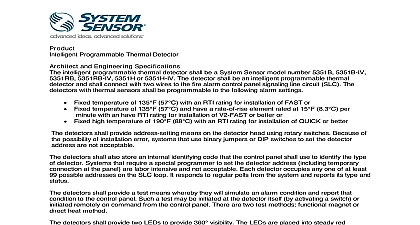System Sensor UL1971-Signaling Devices for the Hearing Impaired

File Preview
Click below to download for free
Click below to download for free
File Data
| Name | system-sensor-ul1971-signaling-devices-for-the-hearing-impaired-5243860971.pdf |
|---|---|
| Type | |
| Size | 817.58 KB |
| Downloads |
Text Preview
White Paper 2012 Compliant Voltage Calculations 1971 Signaling Devices for the Hearing Impaired Revisions Explained Compliant Voltage Drop Calculations UL 1971 Signaling Devices for the Hearing Impaired 2004 Revisions Explained manufacturers fire marshals AHJs and inspectors in the fire protection community standards continually changing Until new standards or revisions are communicated understood and executed fire protection professionals searching for product information may be confused the array of specifications on data sheets This document details key aspects of the May 2004 to UL 1971 Signaling Devices for the Hearing Impaired The revisions standardize how currents are measured and how voltage ranges are listed and published Challenges professionals seeking current draw information for notification appliances may be confused by the various ways are presented on data sheets Despite the revision to UL 1971 standardizing current draw measurements continue to show multiple specifications Because the fire protection community is so large and widespread and standards are continually changing communicating to codes or standards is difficult purpose of this document is to inform fire protection professionals of the revision to UL 1971 Signaling Devices for the Impaired Operating Current and Voltage Specifications May 2004 Underwriters Laboratories UL revised UL 1971 standardizing operating current measurements to provide among manufacturers They now require strobe operating current to be measured using root mean square RMS than peak and average values and surge currents must be maintained within levels that the system power supply can The operating current must be measured at the voltage where the current draw is at its maximum By and large these have been implemented by the industry However confusion is present across the fire industry because current can no longer be specified at the nominal operating voltage of the system on its location on the loop and the many tolerances involved throughout a notification system a device designed regulated 24 volt operation may end up operating at a voltage considerably higher or lower UL has defined this worst case range to be between 16 and 33 volts Devices designed for regulated 12V operation have a worst case voltage range 8 to 17.5V Since device currents vary considerably with applied voltage the only way to guarantee that the power supply provide enough current under all conditions is to specify individual device currents at their highest values Based on this UL implemented the requirement that the current rating published in the installation manual must represent the maximum draw of the device across that range Unfortunately since UL has no control over most printed materials and web sites manufacturers continue to provide current draws taken at 24 volts While this provides an illusion of lower current draws increases the risk of system failure during an emergency situation The maximum RMS current may or may not occur at the endpoints of the voltage range UL has acknowledged that the voltage of a notification appliance is not usually 24 volts This is due to the inherent drop in the circuit Depending where the appliance is positioned on the circuit the voltage will likely drop to minimum operating voltage Sensor Advanced Ideas Advanced Solutions Compliant Voltage Drop Calculations UL 1971 Signaling Devices for the Hearing Impaired 2004 Revisions Explained of Standardizing Operating Current Voltage Specifications RMS measurements better reflect the power consumption of a product because the entire current draw is considered Regulated devices are compatible with regulated outputs on the control panel regardless of manufacturer protection professionals can easily compare manufacturers current draw specifications UL Max Current Specifications Setting Advance Strobe Current Draw Operating Current Volts Volts Operating Current Volts Volts Rectified Current VDC Class B Notification Appliance Circuit NAC regulated foot circuit American Wire Gage AWG wire 110 candela strobes regulated What is the worst case voltage at the end of the loop How much current must the NAC supply be able to furnish Sensor Advanced Ideas Advanced Solutions Compliant Voltage Drop Calculations UL 1971 Signaling Devices for the Hearing Impaired 2004 Revisions Explained UL Max Current Specifications with the NAC supply voltage at the minimum voltage allowed by UL under battery This value is 20.4 volts 15 below 24 VDC see fig 1 a quick calculation assume that all of the devices are at the end of the line Multiply amps for 110 cd by 5 number of strobes That calculation produces 1.010 amps current draw see fig 2 This total current draw plus a factor for will tell what size supply to use Different designers have different rules of thumb for the of overhead needed In this case you may decide to use a 1.5 amp NAC output total resistance of the wire is determined by the amount of resistance per foot for 12 wire 2 ohms per 1000 ft for the length of the circuit In this case the circuit length 500 feet 250 ft times 2 for the supply and return wires see fig 3 The resistance of wire is 1 ohm is equal to resistance times current The voltage drop due to the five devices is volts 1 ohm times 1.010 amps see fig 4 The voltage at the end of line is 19.39 20.4 minus 1.010 see fig 5 This is an acceptable condition since the EOL voltage greater than 16 volts 1 supply voltage x 15 below Minimum voltage allowed by UL battery back up VDC x 0.85 20.4 volts 2 amps x Number of Total current draw amps x 5 1.010 amps 3 per foot of wire Length of circuit Total wire ohms 1000 feet x 500 feet 1 ohm 4 x Current Voltage ohm x 1.010 amps 1.010 volts with any major change to standards in the fire protection industry there is inevitable at first With time however standards are communicated understood and executed and enforced by code officials and or the authority having jurisdiction 5 voltage device voltage end of line voltage volts 1.010 volts 19.39 volts more information please contact Sensor Ohio Avenue Charles Illinois 60174 1 800 sensor2 System Sensor Product specifications subject to change without notice 02 12

